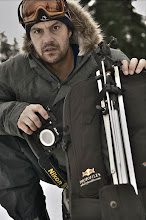There seems to be a fair bit of confusion in the world about camera sync speeds,
Pocket Wizards, and high speed sync so I thought I would try to explain and demonstrate how it all works.
Camera Sync Speed (SLR)Your camera has a set sync speed which is the fastest shutter speed you can use with a flash for that particular camera. So say the camera companies. Knowing how it works can allow for some additional creative processes. I'm going to assume that you know what a shutter is, and the examples here were shot with a
Nikon D2Xs, Canon's work the same way, they both have vertical focal plane shutters. Rather than rewrite what's already been written about shutters I'll refer you to a fairly
good description with diagrams on wikipedia.
The sync speed of your camera is the maximum shutter speed at which the shutter is entirely open. After that point the shutter begins to close before it is fully open, creating a slit that moves across the focal plane as can be seen in these shots below.

"Wait a minute you're saying, how did you shoot faster than the sync speed of the camera, mine won't let me do that!"
Most SLR and DSLR cameras detect that a flash is attached and electronically limit the shutter speed to the maximum sync speed of the camera. By using a PC cord or a
Pocket Wizard or other such remote you can bypass the detection of the flash. If the flash is not on the hot shoe, the camera doesn't know that it's there, and thus it doesn't limit the shutter speed. This can be a good thing if you understand how to use it. As you can see in the images above there is very little difference in the 1/250 shot and the 1/320 shot, if I'm shooting with pocket wizards I frequently shoot at 1/320. Even at 1/500 the flash still covers almost the bottom 2/3 of the frame, so if I position my flash lit subject in that bottom 2/3, and keep the top 1/3 lit by ambient light, everything will be fine. You can use the same trick for vertical shots as well, just keep the flash cropping in mind when you compose.
Pocket Wizard Multimax Fast ModeThe
Pocket Wizard Multimax transceivers have a fast mode that according to the manual allows you to sync up to 1/1000 of a second. Of course that's dependent on your camera's sync speed, and the only camera I know of that can sync at 1/1000 is a Rollei with a PQS lens. It does affect your camera's sync however, as shown in the photos below. The photos with the HS are the ones shot in Fast Mode

As you can see from the images, with Fast mode on the Multimax there is no discernible flash cropping at 1/320, and at 1/400 you still have most of the frame available for flash. At 1/500 and 1/1000 there is a smaller difference, but still good to know about. Please note that every camera is slightly different so you should repeat this test with your own camera before you start using it this way.
Nikon Auto FP High Speed SyncAs I use
Nikon Cameras I won't go into the Canon version of this feature, although i believe it is similar. Nikon pro cameras and the newer Nikon "prosumer" cameras allow you to use what they call "Auto FP High-Speed Sync" mode with the Nikon SB600 and SB800 flashes. It allows you to shoot up to 1/8000 with a flash. It accomplishes this by firing a bunch of vey fast flash pulses instead of one single flash, and these pulses blanket the shutter as it opens and closes so that the entire image is lit. There are several benefits as well as several drawbacks to this feature.
Benefits - As it allows you to shoot at a higher shutter speed you can adjust the ambient light level and keep a lower aperature even in bright daylight. Also you can shoot at a higher shutter speed to freeze action and still use fill flash.
Drawbacks - Because it fires a bunch of flashes the actual flash "duration" becomes much longer making it less than useful for freezing action between 1/250 and 1/1000. Also because it has to fire more than once the effective power level of the flash is greatly reduced, and the recycle time increases. The biggest drawback is the huge reduction in output. My Nikon SB800's at ISO100, 1/2 power, 70mm zoom at @7 feet give me @f8. With the same settings using Auto FP high speed sync I get less than f2.8 Even at full power I get less than f2.8 Not great if you need to have the flash more than a few feet from your subject.
Also this is a feature that is enabled on the camera, not the flash, so it won't work with Pocket Wizards, although the new
Radio Popper wireless TTL system will probably work fairly well with it.
I'll follow up with review of this feature with the
Radio Poppers once I get a set, hopefully fairly soon.
 Last month I got something really exciting in the mail, Bike Magazine, and for the second time in my life I had a photo on the cover of it. What set this cover apart for me was that it was shot at 1/500th of a second with flash. See my post on Camera Sync Speed and Flash for more details.
Last month I got something really exciting in the mail, Bike Magazine, and for the second time in my life I had a photo on the cover of it. What set this cover apart for me was that it was shot at 1/500th of a second with flash. See my post on Camera Sync Speed and Flash for more details.


